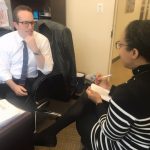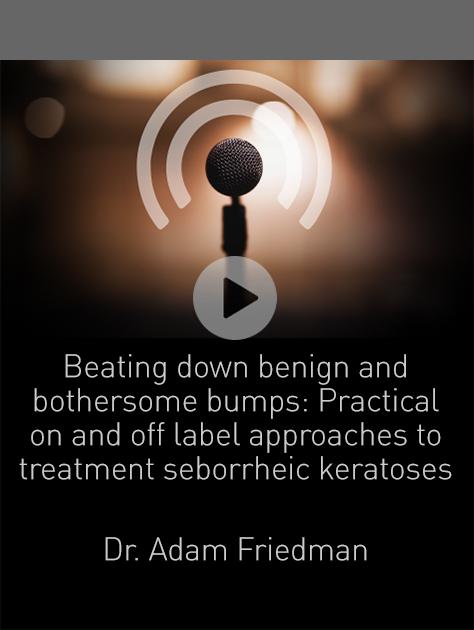A Recap of the JDD October Podcast
Seborrheic keratoses (SKs), though harmless, are one of the most common patient concerns. Their aesthetic impact makes them one of the most common dermatologic complaints, however treatment options are limited. In this special of the JDD podcast series, Dr. Adam Friedman discusses his group’s article “Managing Seborrheic Keratosis: Evolving Strategies and Optimal Therapeutic Outcomes” from the September 2018 issue, and reviews current treatment options for this ubiquitous patient concern.
On the basics of SKs
- Seborrheic keratoses are the most common benign neoplasm of the skin. They affect sun exposed areas and body folds most commonly. There may be a genetic and metabolic contribution to their development.
- While common, SKs are quite variable in appearance. There are 9 different subtypes and they can differ greatly in size.
- Eruptive SKs can be a sign of internal malignancy (sign of Leser-Trelat) or can be seen in patients on adalimumab.
- Sudden onset of inflamed SKs can result from a variety of chemotherapeutics.
- The literature has shown that 53% of patients seeking treatment for SK did so due to appearance alone. 51% had used a method of camouflage for their SKs such as makeup or clothing choice.
- SKs can also be traumatized and inflamed by clothes, activity etc.
- Dr. Friedman notes that some malignancies such as SCCIS, BCC and to a much lesser degree, melanoma can mimic SK. His advice is to biopsy a lesion that was initially diagnosed as an SK if it does not respond to typical treatments such as cryotherapy or 40% benzoyl peroxide.
- Tailor the therapy to the patient, especially to their phototype. Some methods of SK destruction can result in post-inflammatory pigment alteration in darker skinned patients.
On the treatment of SKs with FDA approved topical hydrogen peroxide 40%
- The only FDA approved treatment for SKs is 40% hydrogen peroxide (A-101 or Eskata). This therapy uses the oxidative potential of hydrogen peroxide to damage keratinocytes and induce apoptosis. It was studied in two double-blind clinical trials with treatment of 4 SKs on days 1 and 22 with follow up of 150 days. 13-23% of patients in the treatment group cleared at least 3 of the SKs, with 4-8% clearing all 4. Dr. Friedman notes that while these numbers seem low, they refer to completely normal skin following treatment of the keratosis — in real life there will probably be many more patients that have some sort of intermediate result. The greatest outcomes for SK clearance in these trials were on the face. Redness at the procedure site was the only side effect in the treatment group that was not significantly present in the controls.
- Dr. Friedman and colleagues performed a study, published in the Journal of the American Academy of Dermatology to compare the effect of 40% hydrogen peroxide to cryotherapy with a histologic analysis. They used an ex vivo model of regenerated human skin with a Fitzpatrick V skin type. They compared 40% hydrogen peroxide to 5 and 10 second freezing with liquid nitrogen and then analyzed the treated tissue histologically. It was found that there was more damage to the epidermis in both cryosurgery groups, with complete separation from the dermis. They also found through a special assay that there was greater apoptosis of melanocytes in the cryotherapy groups. They posit that hydrogen peroxide therapy likely presents a lower risk for post-inflammatory pigment alteration, given these results.
On off-label topical therapies for SKs
- The use of tazarotene is supported by a small clinical trial showed a 50% response rate.
- Imiquimod is another topical option – a small trial showed that 32/34 patients showed total clearance after 4 weeks of use.
- Ammonium lactate has been shown to decrease thickness of SKs, but there is little evidence for clearance.
- There is some data showing that alpha-hydroxy acids, such as pyruvate, followed by curettage may be a viable treatment too.
On off-label procedural management of SKs
- Cryosurgery destroys epidermal cells by forming ice crystals within them, resulting in cell lysis and death. Friedman advises “freeze fast and thaw slow” to allow optimal crystal formation within the target keratinocytes. Pros of cryosurgery include low cost and versatility to treat multiple conditions while cons include pain and discomfort, limited efficacy in thicker lesions, and the aforementioned post-inflammatory pigment alteration. Counseling patients about aftercare is important, as vesicles or bullae may develop, and certain sites such as lower legs may take a longer time to heal.
- Electrosurgical procedures such as electrodessication are also an option.
- Laser therapy has been used by some, but there is not large-scale evidence supporting their use.
Dr. Friedman concludes that more data is needed to fully evaluate the efficacy of all of these treatment options and to elucidate the possibility of new options.
Make sure to tune in and listen to the Podcast here.
In addition to highlighting a monthly JDD Podcast, George Washington School of Medicine and Health Sciences residents are given the opportunity to conduct a brief interview with study authors. This month, 2nd year resident Dr. Misty Eleryan, got up and close with Friedman.
 Dr. Eleryan: In your CME article, you discussed the options available for the management of seborrheic keratoses. There are very few studies that address the treatment options for patients with skin of color (Fitzpatrick skin type V-VI). In your academic practice, what is your preferred method of treatment for patients with skin of color that want treatment for their SKs and DPNs?
Dr. Eleryan: In your CME article, you discussed the options available for the management of seborrheic keratoses. There are very few studies that address the treatment options for patients with skin of color (Fitzpatrick skin type V-VI). In your academic practice, what is your preferred method of treatment for patients with skin of color that want treatment for their SKs and DPNs?
Dr. Friedman: I think it is important to tread lightly, first providing realistic expectations and potential pitfalls of our standard approaches such as cryotherapy and hyfercation, to make sure your patient understands the risks associated with an optional and voluntary procedure. I like to say, you are possibly trading one unsightly spot for another. I often will do a free test spot as if the patient is going to pay out of pocket, he or she should probably like the results. For skin of color, I lean to hyfercation over cryotherapy given the sensitivity of melanocytes to extremes in temperature. My team at GW showed in ex vivo organotypic skin models derived from Fitz typeV skin that just 5 seconds of cryotherapy obliterated the DEJ – seeing that histology renewed my fear of using cryotherapy in darker skin.
In this same study, we looked at the recently FDA approved stabilized H2O2 40% solution, trade name Eskata, and found that it was not as caustic as the cryotherapy and yielded greater melanocyte preservation. I know it is being studied clinically in darker skin, but I personally have not had any experience with it as the business model is buy and bill and the powers that be at GW will not let us engage that first B. My assumption based on our research is that it would be safe and effective. Of note, I have also used topical retinoids and keratolytics for hyperkeratotic SKs with variable success.
Dr. Eleryan:What is one piece of advice for current residents and young dermatologists?
Dr. Friedman: Be a yes person – grab any opportunity to advance your career through networking, presentations, publications, committees, etc. FOMO has a place and it is here. I think dermatology is an extremely collegial specialty and most are happy to pay it forward to those in training and newly born into the specialty but do not expect a handout and do not squander the golden ticket. Work hard, do your best, and more engagements will follow. Talks beget talks, grants beget grants… whatever that first opportunity is, own it and more will follow.
Dr. Eleryan:What is one book everyone should read?
Dr. Friedman: There are so many genres of books that I enjoy, this is really tough. I have really gotten into sci-fi trilogies but given the current political climate, I recommend Erik Larson’s In the Garden of Beasts, a historical fiction that follows the US Ambassador to Germany right before the second world war. Not a light read but fascinating.
Did you enjoy this JDD podcast recap? Find more here.

